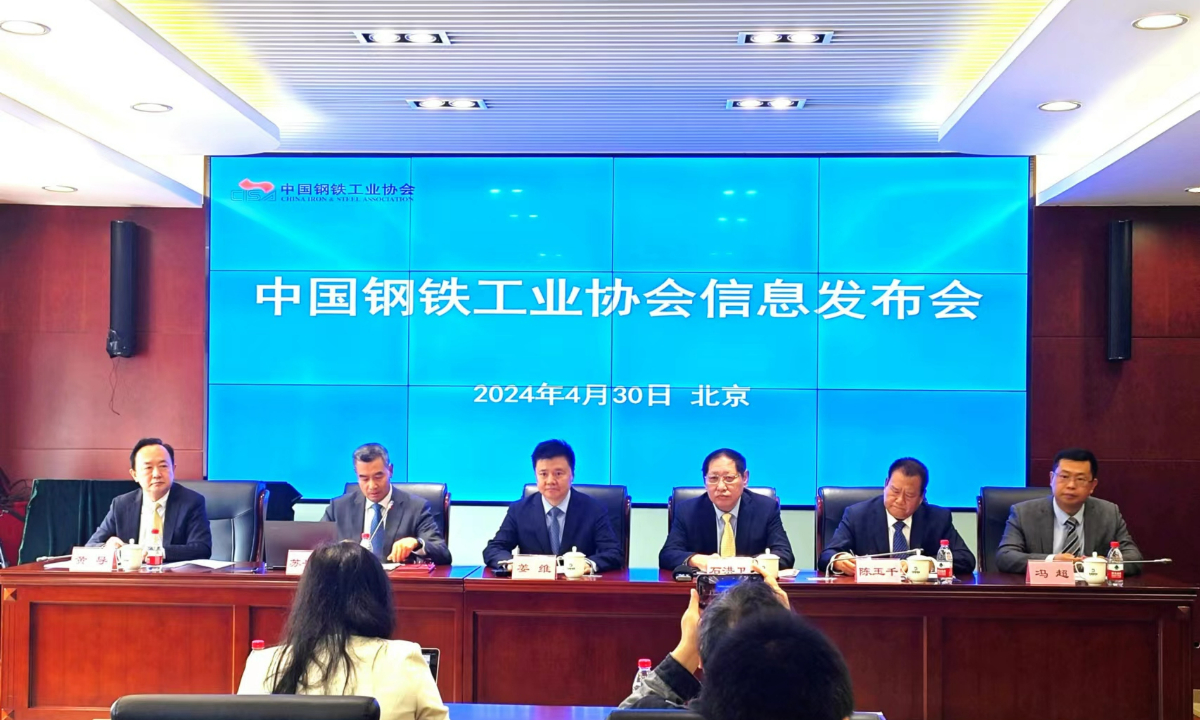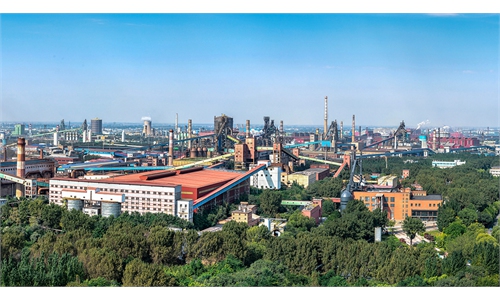China's steel sector embraces industrial upgrade for high-quality development amid challenges

The China Iron and Steel Association holds a press conference addressing the industry’s performance in the first quarter on April 30, 2024. Photo: Yin Yeping/GT
China's steel sector, an important gauge of the national economy, is advancing toward high-quality development by optimizing its product structure, as reported by the China Iron and Steel Association (CISA) during a press conference addressing the first-quarter industry operation report.
Specifically, the proportion of high-end manufacturing steel, including automobiles, household appliances, and photovoltaics, increased from the 42 percent in 2020 to 48 percent in 2023, and has maintained a further upward trend since the beginning of 2024, according to the CISA.
The positive trend reflects a significant acceleration in the restructuring of the steel industry's operating structure, industry insiders noted.
Meanwhile, businesses are contending with multiple hurdles, including diminished market demand, declining steel prices, and escalating iron ore expenses. External factors, such as heightened scrutiny targeting the Chinese steel industry overseas, compound the profitability challenges faced by enterprises, the Global Times learned from the industry body.
Speaking at Tuesday's press conference, Jiang Wei, vice chairman and secretary general of the CISA, said that China's steel industry is embracing high-quality development which have borne positive results so far.
The optimization of steel-related product structures is accelerating in response to ever-growing demand from burgeoning industries such as car manufacturing, shipbuilding, home appliance production, as well as the wind and solar power sectors.
The production upgrade is reflected in the corresponding export volume. In the first quarter, China's high value-added product exports accounted for more than 35 percent, Jiang said.
Efforts are underway to enhance intelligence in steel production and management within the industry. According to a report by the CISA, surveyed companies have invested approximately 38.5 yuan per ton of steel in digital and intelligent transformation initiatives so far this year. This represents a notable year-on-year increase of 23.9 percent.
There were 40 percent of surveyed companies applying 3D visual simulation technology in their main production lines, another reflection of the industry digitalization and upgrade, according to the CISA.
In addition, domestic steel companies are actively pursuing green transformation, another key element of high-quality development. As of April 23, 2024, a total of 136 companies had either completed or partially completed ultra-low emission transformations and undergone assessment monitoring.
Challenges persist in China's steel industry, primarily stemming from a significant structural imbalance between market supply and demand. Difficulties also include declining steel prices and high iron ore prices, according to the CISA.
In the first quarter, the national crude steel production came to 257 million tons, a year-on-year decrease of 1.9 percent. Meanwhile, nationwide consumption of crude steel was 232 million tons, a decrease of 4.7 percent year-on-year, indicating a surplus in steel supply over demand.
National steel exports reached 25.8 million tons in the first quarter, marking a year-on-year increase of 30.7 percent, while the average export price stood at $789 per ton, reflecting a decline of 33.4 percent year-on-year, suggesting thinner profit margins for companies despite strong demand overseas.
Meanwhile, the high price of iron ore, a key raw material for steelmaking, remained elevated, serving as another factor affecting company profits. The primary cause behind this is the lack of bargaining power in international pricing negotiations, Shi Hongwei, deputy secretary general of the CISA, said on Tuesday.
Inventories of domestic steel companies were also on the rise. As of mid-March, key steel enterprises reported steel inventory levels of 19.53 million tons, the highest level since the beginning of this year and the highest level in nearly four years, trailing only the 21.41 million tons during the 2020 pandemic period, according to the CISA.
The high inventory reflects the juxtaposition of weak market demand with strong market expectations for the economy, which have supported stockpiling.
Looking ahead, China's steel industry remains optimistic despite certain and temporary challenges.
Despite the challenges, the steel industry's structure is continually optimizing in pursuit of high-quality development, as industry insiders said, with manufacturing figures being a reflection.
In April, China's Manufacturing Purchasing Managers' Index stood at 50.4 percent, down 0.4 percent from the previous month, remaining in the expansionary zone for two consecutive months. This indicates the continued recovery and development momentum of the manufacturing industry, according to data released by the National Bureau of Statistics Service Industry Survey Center on Tuesday.
As China further ramps up its investment in new energy and the development of infrastructure, which are major consumers of steel, and implements policies promoting the trade-in or the replacement of old equipment with new, there will be a boost in steel demand, industry insiders said.

